落日上的AR 3664
在水面上和前景树木之间可以看到远处的太阳。太阳的下部是巨大的活跃区AR 3664可见的黑暗的太阳黑子。有关更多详细信息,请参阅说明。

在水面上和前景树木之间可以看到远处的太阳。太阳的下部是巨大的活跃区AR 3664可见的黑暗的太阳黑子。有关更多详细信息,请参阅说明。

太阳以黑白两色显示,在最右边是黑色的太阳黑子。大的太阳黑子群在左下角的嵌入图像中展开。有关更多详细信息,请参阅说明。

2023年12月11日 Solar Minimum versus Solar Maximum Video Credit: NASA, SDO, SVS Explanation: The surface of our Sun is constantly changing. Some years it is quiet, showing relatively few sunspots and active regions. Other years it is churning, showing many sunspots and throwing frequent Coronal Mass Ejections (CMEs) and flares. Reacting to magnetism, our Sun’s surface goes through periods of relative calm, called Solar Minimum and relative unrest, called Solar Maximum, every 11 years. The featured video shows on the left a month in late 2019 when the Sun was near Solar Minimum, while on the right a month in 2014 when near Solar Maximum. The video was taken by NASA’s Solar Dynamic Observatory in far ultraviolet light. Our Sun is progressing again toward Solar Maximum…

2023年7月11日 Sunspots on an Active Sun Image Credit: NASA, SDO; Processing & Copyright: Şenol Şanlı Explanation: Why is our Sun so active now? No one is sure. An increase in surface activity was expected because our Sun is approaching solar maximum in 2025. However, last month our Sun sprouted more sunspots than in any month during the entire previous 11-year solar cycle — and even dating back to 2002. The featured picture is a composite of images taken every day from January to June by NASA‘s Solar Dynamic Observatory. Showing a high abundance of sunspots, large individual spots can be tracked across the Sun’s disk, left to right, over about two weeks. As a solar cycle continues, sunspots typically appear closer to the equator. Sunspots…

2023年5月17日 Sunspot with Light Bridge Image Credit & Copyright: Mark Johnston Explanation: Why would a small part of the Sun appear slightly dark? Visible is a close-up picture of sunspots, depressions on the Sun’s surface that are slightly cooler and less bright than the rest of the Sun. The Sun’s complex magnetic field creates these cool regions by inhibiting hot material from entering the spots. Sunspots can be larger than the Earth and typically last for about a week. Part of active region AR 3297 crossing the Sun in early May, the large lower sunspot is spanned by an impressive light bridge of hot and suspended solar gas. This high-resolution picture also shows clearly that the Sun’s surface is a bubbling carpet of separate cells…
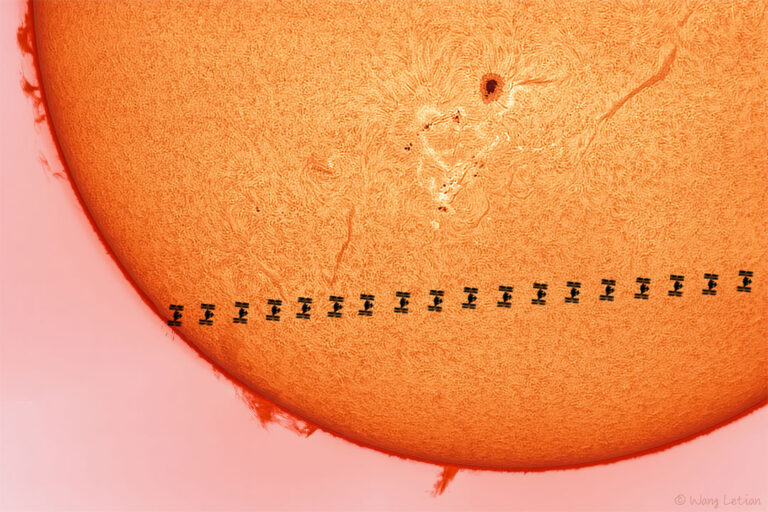
2022年4月11日 A Space Station Crosses a Busy Sun Image Credit & Copyright: Wang Letian (Eyes at Night) Explanation: Typically, the International Space Station is visible only at night. Slowly drifting across the night sky as it orbits the Earth, the International Space Station (ISS) can be seen as a bright spot several times a year from many locations. The ISS is then visible only just after sunset or just before sunrise because it shines by reflected sunlight — once the ISS enters the Earth’s shadow, it will drop out of sight. The only occasion when the ISS is visible during the day is when it passes right in front of the Sun. Then, it passes so quickly that only cameras taking short exposures can visually…
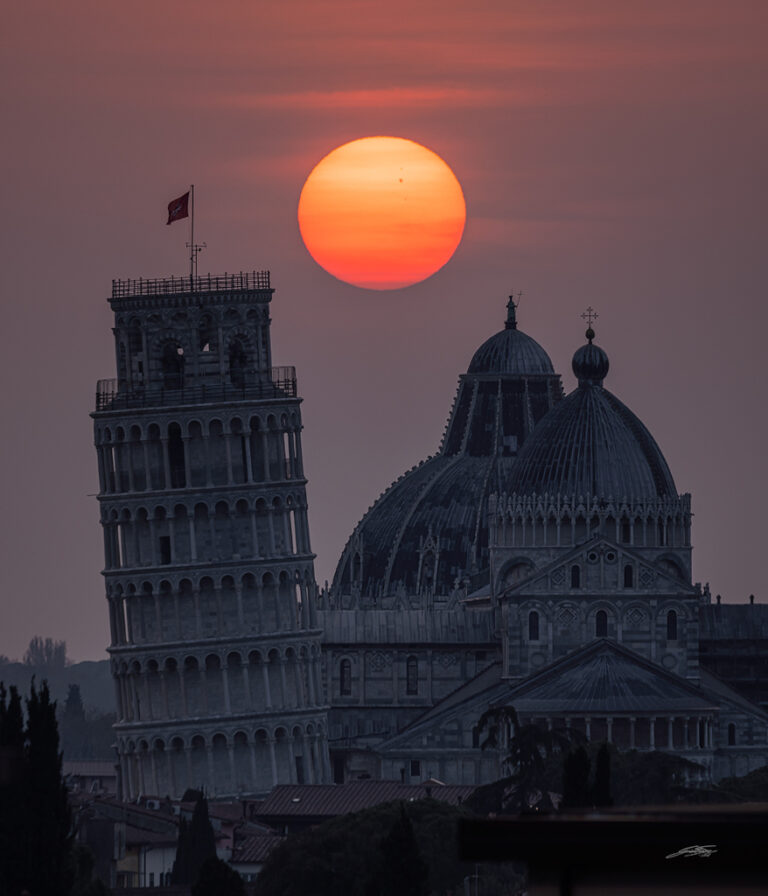
2022年4月1日 Leaning Tower, Active Sun Image Credit & Copyright: Antonio Tartarini Explanation: The natural filter of a hazy atmosphere offered this recognizable architecture and sunset view on March 27. Dark against the solar disk, large sunspots in solar active regions 2975 and 2976 are wedged between the Duomo of Pisa and its famous Leaning Tower. Only one day later, Sun-staring spacecraft watched active region 2975 unleash a frenzy of solar flares along with two coronal mass ejections. The largest impacted the magnetosphere on March 31 triggering a geomagnetic storm and aurorae in high-latitude night skies. On March 30, active region 2975 erupted again with a powerful X-class solar flare that caused a temporary radio blackout on planet Earth. Tomorrow’s picture: a colour out of space…
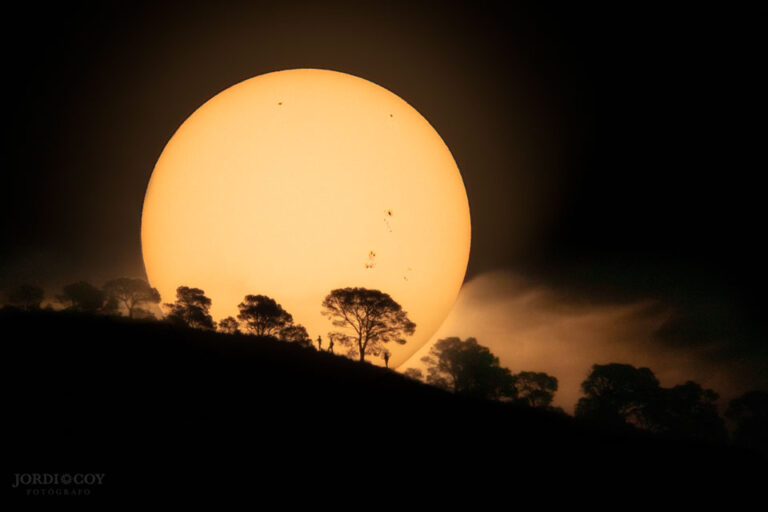
2021年9月21日 Sun Spot Hill Image Credit & Copyright: Jordi Coy Explanation: Is this giant orange ball about to roll down that tree-lined hill? No, because the giant orange ball is actually the Sun. Our Solar System’s central star was captured rising beyond a hill on Earth twelve days ago complete with a delightfully detailed foreground. The Sun’s disk showed five sunspots, quite a lot considering that during the solar minimum in solar activity of the past few years, most days showed no spots. A close look at the hill — Sierra del Cid in Perter, Spain — reveals not only silhouetted pine trees, but silhouetted people — by coincidence three brothers of the photographer. The trees and brothers were about 3.5-kilometers away during the morning…
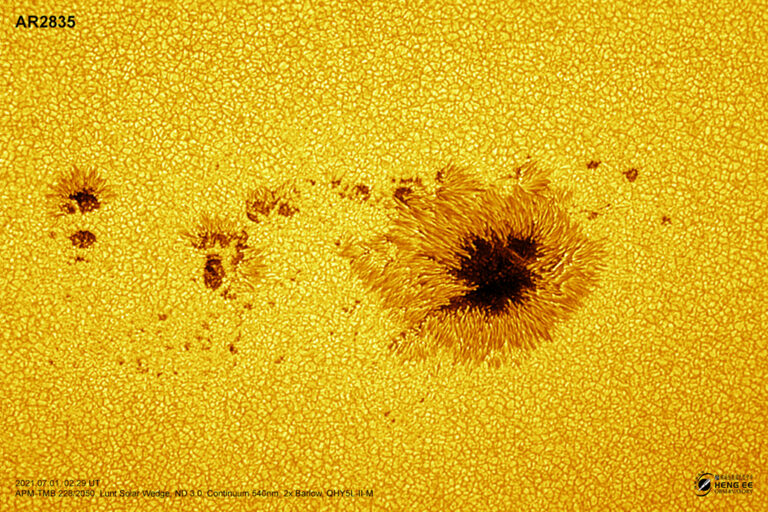
2021年07月02日 AR2835: Islands in the Photosphere Image Credit & Copyright: Michael Teoh, Heng Ee Observatory, Penang, Malaysia Explanation: Awash in a sea of incandescent plasma and anchored in strong magnetic fields, sunspots are planet-sized dark islands in the solar photosphere, the bright surface of the Sun. Found in solar active regions, sunspots look dark only because they are slightly cooler though, with temperatures of about 4,000 kelvins compared to 6,000 kelvins for the surrounding solar surface. These sunspots lie in active region AR2835. The largest active region now crossing the Sun, AR2835 is captured in this sharp telescopic close-up from July 1 in a field of view that spans about 150,000 kilometers or over ten Earth diameters. With powerful magnetic fields, solar active regions are…
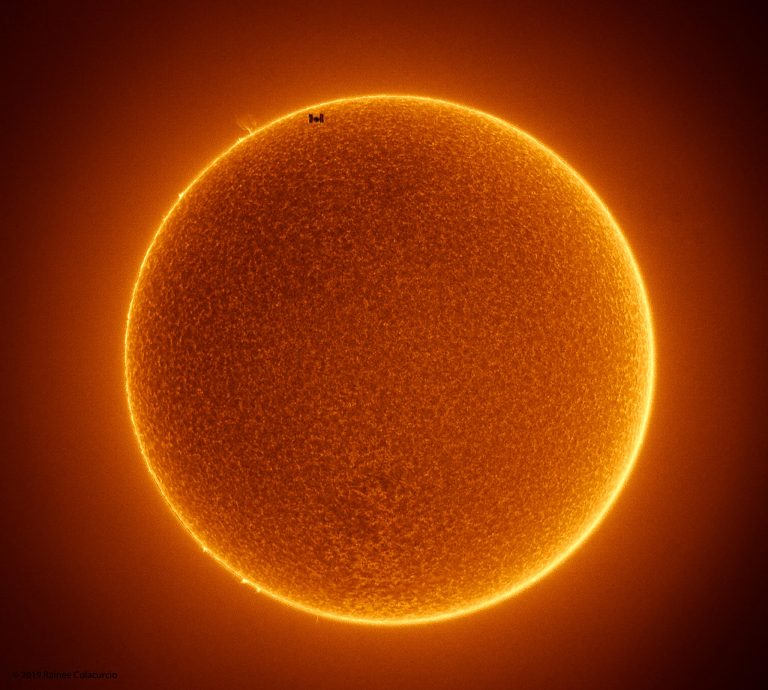
2019 July 15 The Space Station Crosses a Spotless Sun Image Credit & Copyright: Rainee Colacurcio Explanation: That’s no sunspot. It’s the International Space Station (ISS) caught passing in front of the Sun. Sunspots, individually, have a dark central umbra, a lighter surrounding penumbra, and no solar panels. By contrast, the ISS is a complex and multi-spired mechanism, one of the largest and most sophisticated machines ever created by humanity. Also, sunspots occur on the Sun, whereas the ISS orbits the Earth. Transiting the Sun is not very unusual for the ISS, which orbits the Earth about every 90 minutes, but getting one’s timing and equipment just right for a great image is rare. Strangely, besides that fake spot, in this recent two-image composite, the…